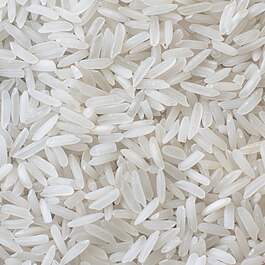Jasmine rice: Difference between revisions
m →References: fixed CS1 errors: dates to meet MOS:DATEFORMAT (also General fixes), removed stub tag using AWB (10069) |
HeyItsAedan (talk | contribs) there is no decisive proof of this yet. |
||
| Line 22: | Line 22: | ||
=== White jasmine rice === |
=== White jasmine rice === |
||
White jasmine rice is white, has a jasmine aroma and, when cooked, a slightly sticky texture.<ref name="book2">{{cite book|last=K. Khunket, A. Wutthanet, A. Prasertsak, S. Traprap, K. Cheungpun, W. Chamalerk, K. Nakrang, S. Wongpiyachon, B. Warinruk, P. Mekawutthanakarn, S. Jaidee, N. Piyachotisakulchai, P. Srikhum, R. Changsri, T. Cheunban, W. Ruttanakarn, W. Khemmuk|title=ข้าวขาวดอกมะลิ 105|publisher=กรมการข้าว สำนักวิจัยและพัฒนาข้าว|location=THAILAND|pages=8–13}}</ref> The aroma is caused by the [[evaporation]] of [[2-Acetyl-1-pyrroline]].<ref name="book2"/> |
White jasmine rice is white, has a jasmine aroma and, when cooked, a slightly sticky texture.<ref name="book2">{{cite book|last=K. Khunket, A. Wutthanet, A. Prasertsak, S. Traprap, K. Cheungpun, W. Chamalerk, K. Nakrang, S. Wongpiyachon, B. Warinruk, P. Mekawutthanakarn, S. Jaidee, N. Piyachotisakulchai, P. Srikhum, R. Changsri, T. Cheunban, W. Ruttanakarn, W. Khemmuk|title=ข้าวขาวดอกมะลิ 105|publisher=กรมการข้าว สำนักวิจัยและพัฒนาข้าว|location=THAILAND|pages=8–13}}</ref> The aroma is caused by the [[evaporation]] of [[2-Acetyl-1-pyrroline]].<ref name="book2"/> {{citation needed|date=December 2013}} It also has [[melatonin]] which helps with sleeping.<ref name="welovelb">{{cite web|title=The benefits of Thai jasmine rice|url=http://welovelbshop.blogspot.com/2012/04/blog-post_9068.html|publisher=welovelb|accessdate=October 20}}</ref>{{verification needed|date=December 2013}} |
||
[[File:Thai jasmine rice uncooked.jpg|thumb|center|265px|White jasmine rice]] |
[[File:Thai jasmine rice uncooked.jpg|thumb|center|265px|White jasmine rice]] |
||
Revision as of 02:56, 1 June 2014

Jasmine rice (Template:Lang-th; RTGS: Khao Hom Mali; Thai pronunciation: [kʰâːw hɔ̌ːm malíʔ]), sometimes known as Thai fragrant rice, is a long-grain variety of rice that has a nutty aroma and a subtle pandan-like (Pandanus amaryllifolius-leaves) flavor caused by 2-Acetyl-1-pyrroline.[1] Jasmine rice is originally from Thailand. It was named as Kao Dok Mali 105 variety (KDML105) by Sunthorn Seehanern, an official of the Ministry of Agriculture in the Chachoengsao Province of Thailand in 1954.[citation needed] The grains will cling when cooked, though it is less sticky than other rices as it has less amylopectin. It is also known as Thai Hom Mali. To harvest jasmine rice, the long stalks are cut and threshed. The rice can then be left in a hulled form and sold as brown rice or shucked and sold as white rice. Most Southeast Asians prefer the white variety of jasmine rice.[citation needed]
Particular varieties of US-grown rice have been found to contain higher levels of arsenic due to the historical use of arsenic based pesticides in some parts of the country. Rice from Thailand and India contains the least arsenic among rice varieties.[2]
Types
Cambodian and Thai jasmine rice share the same characteristics and grow mainly in neighbouring geographic areas on opposite sides of the Northeastern Thai-Cambodian border. Cambodian jasmine rice (in Khmer: Phka Malis) is cultivated in Cambodia and processed as white (milled and polished) and brown rice. Distinct Cambodian jasmine rice varieties include these major three, namely Phka Rumduol, Phka Romeat and Phka Rumdeng. Recent DNA finger print analysis, carried out with 18 markers show that all three varietals possess 18 known fragrance allele. Two varietals (Phka Rumduol and Phka Rumdeng) are distinct Cambodian with 17 markers in identical position with Thai jasmine rice and one fragrance marker each in a different position. The analysis of Cambodian Phka Romeat shows all 18 markers in identical positions with the trademarked Thai jasmine rice Thai Hom Mali [3]
Thai jasmine rice comes from Thailand, has a slender shape and a jasmine scent.[4] There are two types of Thai jasmine rice, white and brown.[5]
White jasmine rice
White jasmine rice is white, has a jasmine aroma and, when cooked, a slightly sticky texture.[6] The aroma is caused by the evaporation of 2-Acetyl-1-pyrroline.[6] [citation needed] It also has melatonin which helps with sleeping.[7][verification needed]

Brown jasmine rice
Brown jasmine rice retains the light tan outer layer on the rice grain.[7] It has greater health benefits than white jasmine rice because it still has the bran which has many benefits.[8] Brown jasmine rice has a flavor like oats and contains gamma oryzanol which can decrease cholesterol in blood vessels.[9] Brown jasmine rice has vitamins such as vitamin A, vitamin B and beta-carotene[10] and it contains antioxidants which support the working of nervous system and help fight cancer.[7][verification needed]
See also
References
- ^ S. Wongpornchai, T. Sriseadka, S. Choonvisase (2003). "Identification and quantitation of the rice aroma compound, 2-acetyl-1-pyrroline, in bread flowers (Vallaris glabra Ktze)". J. Agric. Food. Chem. 51 (2): 457–462. doi:10.1021/jf025856x. PMID 12517110.
{{cite journal}}: CS1 maint: multiple names: authors list (link) - ^ Carol Potera (June 2007). "Food Safety: U.S. Rice Serves Up Arsenic". Environmental Health Perspectives. 115 (6): A296. doi:10.1289/ehp.115-a296. PMC 1892142. PMID 17589576.
- ^ http://www.cardi.org.kh/index.php?page=detail&ctype=article&id=212&lg=en
- ^ K. Khunket, A. Wutthanet, A. Prasertsak, S. Traprap, K. Cheungpun, W. Chamalerk, K. Nakrang, S. Wongpiyachon, B. Warinruk, P. Mekawutthanakarn, S. Jaidee, N. Piyachotisakulchai, P. Srikhum, R. Changsri, T. Cheunban, W. Ruttanakarn, W. Khemmuk. ข้าวขาวดอกมะลิ 105. THAILAND: กรมการข้าว สำนักวิจัยและพัฒนาข้าว. pp. 12–13.
{{cite book}}: CS1 maint: multiple names: authors list (link) - ^ W. Leanjumroon, N. Yuwanaboon. หอมกลิ่นข้าวมะลิหอม. THAILAND: BIOTHAI. p. 10.
- ^ a b K. Khunket, A. Wutthanet, A. Prasertsak, S. Traprap, K. Cheungpun, W. Chamalerk, K. Nakrang, S. Wongpiyachon, B. Warinruk, P. Mekawutthanakarn, S. Jaidee, N. Piyachotisakulchai, P. Srikhum, R. Changsri, T. Cheunban, W. Ruttanakarn, W. Khemmuk. ข้าวขาวดอกมะลิ 105. THAILAND: กรมการข้าว สำนักวิจัยและพัฒนาข้าว. pp. 8–13.
{{cite book}}: CS1 maint: multiple names: authors list (link) - ^ a b c "The benefits of Thai jasmine rice". welovelb. Retrieved October 20.
{{cite web}}: Check date values in:|accessdate=(help) - ^ "Benefits of Brown jasmine rice". Manob Keawsanid. Retrieved October 20, 2013.
- ^ "Jasmine Rice Health Benefits, Nutrition Facts". diethealthclub. Retrieved October 20, 2013.
- ^ "The benefits of jasmine rice". Hommali. Retrieved October 27, 2013.

